The DNR Division of Forestry recently finalized updates to the Forest Tax Law Handbook, Chapter 221, regarding the Managed Forest Law Certified Group. This chapter contains procedures required to conform with third-party forest certification and serves to inform group stakeholders of how the MFL Certified Group works. The update constituted a holistic rewrite of the original Ch. 21 of the Forest Tax Law Handbook. Find a detailed summary of the changes made. Continue reading “Forest Tax Law Handbook Forest Certification Chapter Updated”
Following The Right Path
Note: This is the first in a series of articles featuring Managed Forest Law landowners. This feature of Jim Schiller was written by Art Kabelowsky, a communications specialist in the Division of Forestry. Kabelowsky took the photos as well.
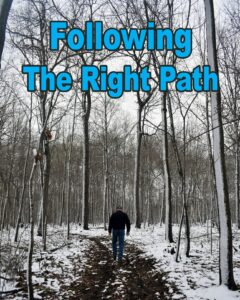
Forest landowner Jim Schiller teams up with DNR’s Managed Forest Law program on his successful woodland property near New Glarus.
Not even a chilly, overcast Monday afternoon could dampen the enthusiasm of Jim Schiller as he showed off his favorite place.
While taking a visitor on a tour of his 29-acre woodlot west of New Glarus in Green County, Schiller paused frequently to explain the past, present and future of each section of the property.
A few red oak trees here, some walnut trees there, a group of white oak trees planned on the other side of the path … spots where he’ll plant conifer seedlings to help protect his deciduous trees … areas where he has begun work to control invasive species such garlic mustard … his thoughts on when and what to harvest.
“You’ve always got to be thinking ahead,” Schiller said. “That’s the main thing I’ve gotten out of all of this.” Continue reading “Following The Right Path”
Douglas County Joins Spongy Moth Quarantine
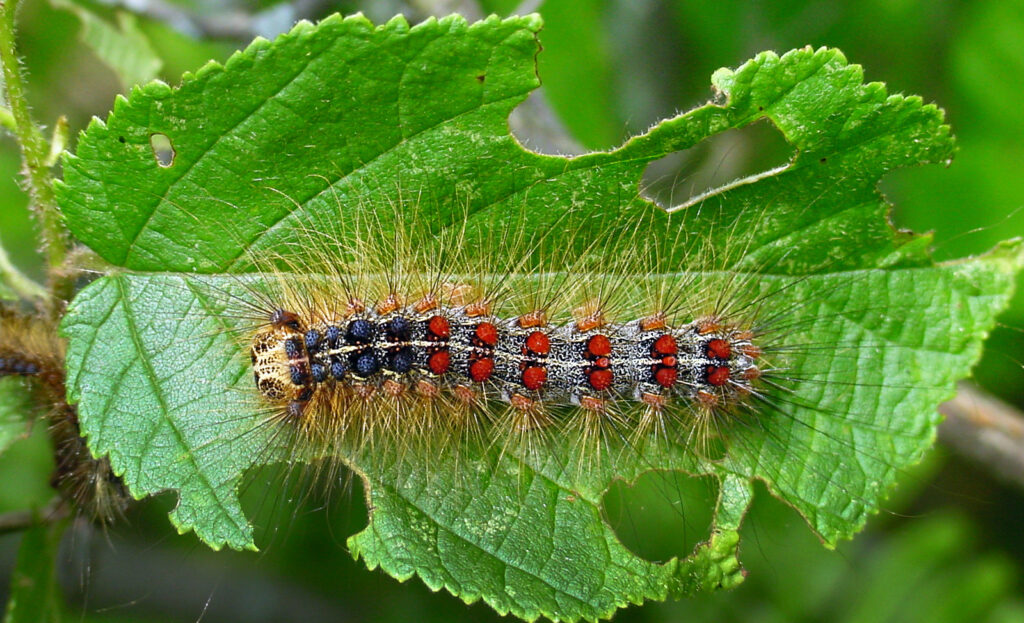
A spongy moth larva eats a leaf.
By Paul Cigan, DNR plant pest and disease specialist
Paul.Cigan@wisconsin.gov or 715-416-4920
In early April, Douglas County became the 53rd Wisconsin county added to the state’s spongy moth quarantine list after a discovery that the invasive insect (formerly known as gypsy moth) had become established in the county.
The United States Department of Agriculture-Animal and Plant Health Inspection Service (USDA-APHIS) and the Wisconsin Department of Agriculture, Trade and Consumer Protection (DATCP) made the determination based on results of a monitoring program of adult moths and other life stages.
Continue reading “Douglas County Joins Spongy Moth Quarantine”
Aerial Spraying Coming To Four State Properties
By Bill McNee, DNR Forest Health Specialist, Oshkosh
bill.mcnee@wisconsin.gov or 920-360-0942
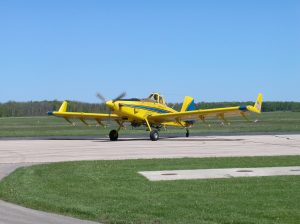
Spray aircraft used in spongy moth control. Photo: Bill McNee, Wisconsin DNR
The Wisconsin Department of Natural Resources (DNR) is taking action in the coming weeks in its battle against spongy moth (formerly known as gypsy moth) caterpillars.
An airplane will spray parts of four DNR properties to reduce the population of the hungry pest.
This year, high numbers of spongy moths threaten to strip trees of their leaves and may even kill high-value trees at these properties.
Continue reading “Aerial Spraying Coming To Four State Properties”
Prepare — Spongy Moth Caterpillars To Return
By Bill McNee, DNR Forest Health Specialist, Oshkosh
bill.mcnee@wisconsin.gov or 920-360-0942
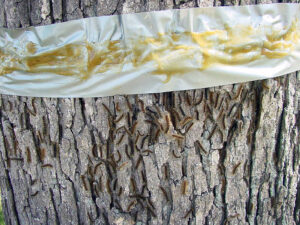
Spongy moth caterpillars clustered below a sticky barrier. Photo: Mark Guthmiller, Wisconsin DNR
This June and July, spongy moth populations are predicted to reach damaging levels in parts of Wisconsin. Populations began to rise in 2020, and this is likely to be the third year of the pest outbreak in some regions of southern Wisconsin.
At present, damaging populations are expected to be most noticeable in southern counties, counties to the north of the city of Green Bay, and in far northern Wisconsin near Lake Superior. Additional areas are likely to have high populations that are more concentrated in size.
Continue reading “Prepare — Spongy Moth Caterpillars To Return”
Emerald Ash Borer Found In Vilas County
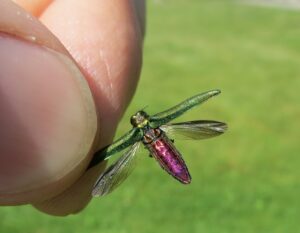
Adult emerald ash borer beetle. Photo: Wisconsin DNR.
By Linda Williams, DNR Forest Health Specialist, Woodruff
Linda.Williams@wisconsin.gov or 920-360-0665
Vilas County has the dubious distinction of becoming the first new Wisconsin county in 2023 to have a discovery of emerald ash borer (EAB).
EAB continues to spread into areas of northern Wisconsin. The first Vilas County detection was in the town of Lincoln. Additional infested trees have since been found in the town of Cloverland and the city of Eagle River. Continue reading “Emerald Ash Borer Found In Vilas County”
Effects Of Winter Take Toll On Trees
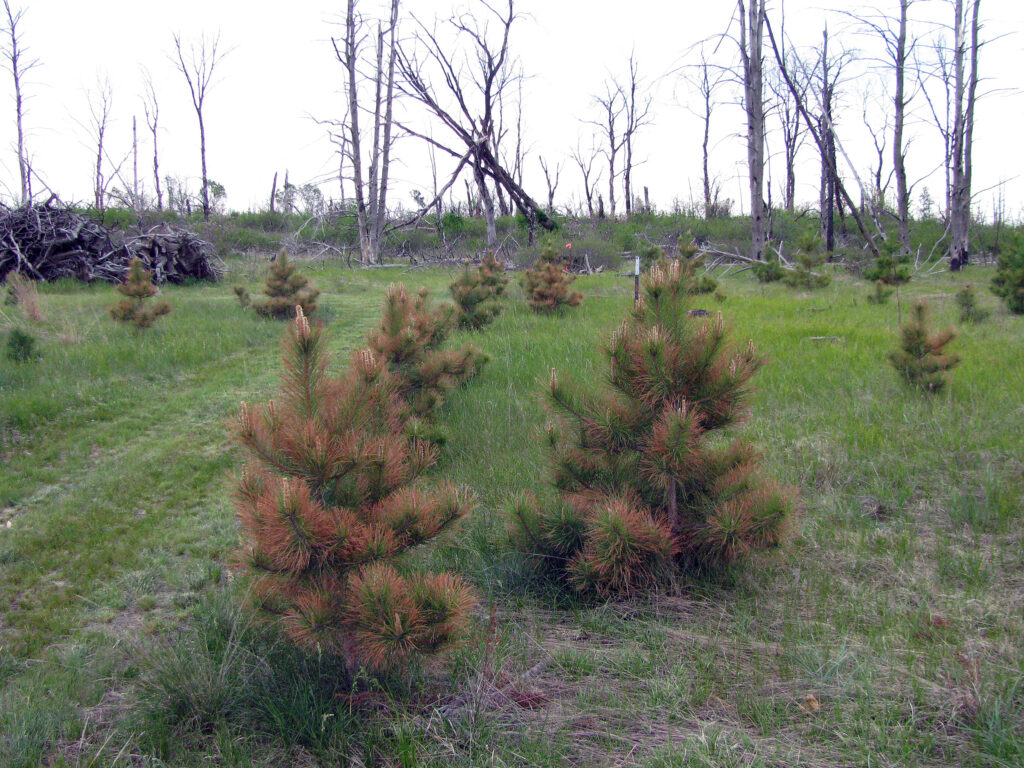
Minor to moderate damage to white pine needles caused by winter desiccation. Photo: Wisconsin DNR
By Michael Hillstrom, DNR Forest Health Specialist, Fitchburg
michael.hillstrom@wisconsin.gov
Winter damage is one of the most commonly reported tree issues in early spring. The damage may be minor, such as off-color needles that are quickly replaced, but could be as severe as partial- or whole-tree mortality.
Winter desiccation occurs when conifers begin photosynthesizing on warm, windy days in late winter or early spring. Conifers may dry out in these conditions if they use their stored water and cannot replace it because the ground is still frozen.
USDA Seeks Donations Of Infested Ash Trees
By Kyle Loughlin, Field Team Lead, USDA-APHIS
kyle.m.loughlin@usda.govor 734-732-0025
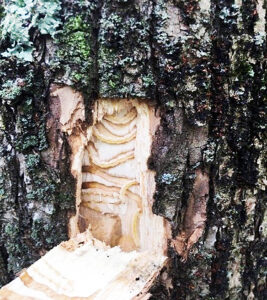
USDA staff cut a ‘bark window’ in green ash to uncover signs of emerald ash borer. Photo: US Department of Agriculture
The U.S. Department of Agriculture (USDA) is asking Wisconsin landowners for help in the battle against emerald ash borer (EAB).
EAB is an invasive insect from Asia that was first introduced into the United States in 2002. Since its discovery, EAB has caused the death and decline of tens of millions of ash trees.
The USDA is asking Wisconsin landowners to donate live ash trees infested with EAB to support USDA’s biological control program. The staff will use the wood to rear EAB’s natural enemies, which will then be released in Wisconsin and 31 other EAB-infested states and Washington, D.C.
Continue reading “USDA Seeks Donations Of Infested Ash Trees”
Applying Directly To The Forest Service For Inflation Reduction Act Funds
The Urban and Community Forestry (UCF) Inflation Reduction Act (IRA) Notice of Funding Opportunity (NOFO) has been announced. Please see the USDA press release here.
Overview:
The Forest Service is making up to $1 billion available in Urban and Community Forestry competitive grants for investments that:
- increase equitable access to urban tree canopy and associated human health, environmental, and economic benefits in disadvantaged communities
- broaden community engagement in local urban forest planning
- improve community and urban forest resilience to climate change, pests and storm events through best management and maintenance practices
Continue reading “Applying Directly To The Forest Service For Inflation Reduction Act Funds”
Report Tree-Of-Heaven To Help Monitor For Spotted Lanternfly
By Anne Pearce, Invasive Plants Association of Wisconsin
Spotted lanternfly is on its way to Wisconsin
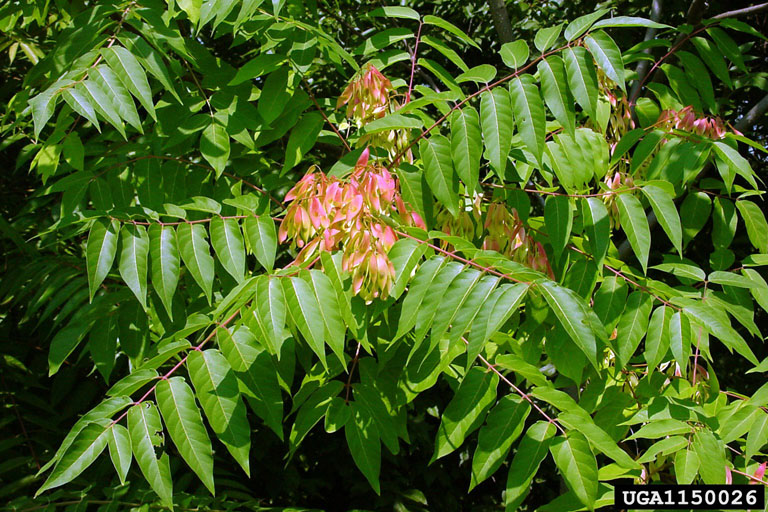
Tree-of-heaven showing leaves and fruits. Photo: Chuck Bargeron, University of Georgia, Bugwood.org
Spotted lanternfly (Lycorma delicatula) is an invasive insect that threatens a variety of plant species, mostly woody plants. It has not yet been found in Wisconsin, but it is steadily moving toward us from the eastern United States. Both juvenile (nymphs) and adult spotted lanternfly feed by sucking sap from the stem, branches, twigs and leaves of host plants. This weakens the plant and can contribute to the plant’s death. Because spotted lanternfly impacts a wide variety of agricultural crops (like grapes and hops), nursery crops (like roses), and hardwood trees (like maple, walnut, willow, and poplar), it is a high priority pest in Wisconsin.
Continue reading “Report Tree-Of-Heaven To Help Monitor For Spotted Lanternfly”
